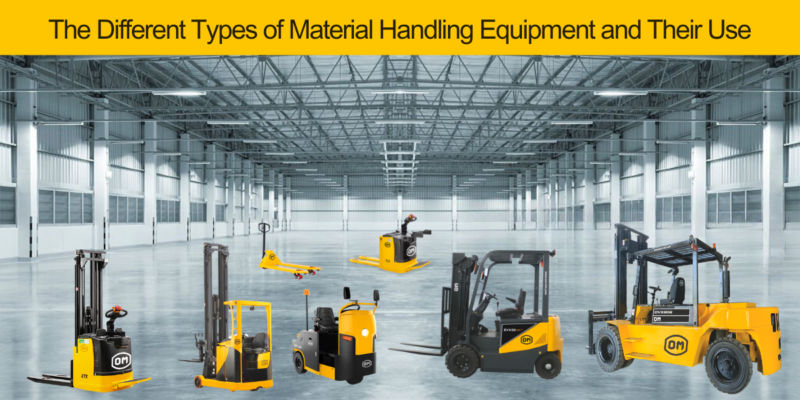Material handling equipment (MHE) is the backbone of industrial operations, ensuring the safe, efficient movement of goods and materials across warehouses, factories, and distribution centers. Whether it’s loading, transporting, or stacking, the right equipment makes all the difference in optimizing workflows and reducing operational costs. Each type of equipment is designed with a specific use in mind, allowing businesses to tailor their handling strategies to their unique needs. Let’s explore the different types of MHE and their primary applications.
1. Forklifts
Forklifts are perhaps the most recognizable piece of material handling equipment in any warehouse. These vehicles are used to lift, move, and transport materials over short distances, making them ideal for both indoor and outdoor operations. Forklifts come in various types:
Diesel Forklifts: Typically used for outdoor environments, diesel forklifts are powerful and capable of handling heavy loads. Their rugged build allows them to perform well in tough conditions, such as construction sites or outdoor storage areas.
Electric forklifts: These, ideal for indoor use, are known for their quiet operation, eco-friendliness, and efficiency. They are commonly used in warehouses with limited ventilation since they produce no harmful emissions. Electric forklifts have gained popularity in modern industrial environments due to their lower operational costs, reduced noise, and environmentally friendly design. Among them, lithium-ion forklifts stand out, utilizing advanced batteries that charge faster, last longer, and are more energy-efficient than traditional lead-acid batteries. They also require less maintenance and allow for opportunity charging, making them a preferred choice in settings where energy efficiency and minimizing downtime are essential.
2 .Pallet Trucks
Pallet trucks, also known as pallet jacks, are used for moving palletized loads in warehouses, storage facilities, and retail spaces. These come in two main types:
Manual Pallet Trucks: Operated by hand, manual pallet trucks are a simple, cost-effective solution for moving lighter loads. While they require physical effort, they are easy to use and maintain.
Battery Operated Pallet Trucks: For heavier loads or more frequent use, battery-operated pallet trucks offer more power and efficiency, making them a staple in large warehouses with high volumes of goods to move.
Pallet trucks are ideal for transporting palletized goods across short distances, such as within aisles in a warehouse or between loading docks.
3. Stackers
Stackers are specialized pieces of equipment designed to lift and stack loads at various heights. Unlike forklifts, stackers are often more compact, making them ideal for smaller spaces. There are different types of stackers depending on the power source:
Manual Stackers: These are operated by hand, much like manual pallet trucks, and are suitable for small warehouses or shops with limited budgets and less frequent lifting needs.
Electric Stackers: Powered stackers are more efficient for frequent use and can lift heavier loads to higher elevations.
4.Tow Trucks
To w trucks, in a warehouse setting, are used to tow heavy loads across large spaces. Unlike conventional forklifts, tow trucks are designed specifically for horizontal transportation, making them suitable for moving multiple loads simultaneously. They come in both manual and electric models, depending on the application and load size. Tow trucks are often employed in large warehouses or manufacturing plants to transport goods or materials between different stages of production.
5. Reach Trucks
Reach trucks are designed for warehouses with narrow aisles and high racks. Their extending forks allow them to “reach” into racks to retrieve or place pallets without needing to move the entire vehicle closer to the rack. This feature makes them particularly useful for maximizing vertical storage in tight spaces.
Reach trucks are ideal for high-density storage facilities where maximizing space is critical. They enable efficient retrieval of goods stored at higher elevations in narrow aisle environments.
The Role of Material Handling Equipment in Operational Efficiency
Investing in the right type of material handling equipment is essential for ensuring operational efficiency. From reducing labor costs to improving worker safety, the benefits of using specialized equipment tailored to specific tasks cannot be overstated. Each type of material handling equipment serves a unique purpose, and understanding the specific needs of your business will allow you to select the most appropriate tools.
A well-organized warehouse with the correct equipment can reduce lead times, optimize space, and enhance productivity. Furthermore, with advancements like lithium-ion batteries and electric stackers, companies can reduce their environmental impact while maintaining high levels of operational efficiency.
Conclusion
In the rapidly evolving world of material handling, choosing the right equipment is vital for ensuring that your operations run smoothly, efficiently, and safely. With a wide variety of options ranging from diesel forklifts to electric stackers, businesses can tailor their material handling strategies to their specific needs. OM, with its extensive range of forklifts, pallet trucks, and stackers, is at the forefront of this industry. Offering innovative solutions that prioritize performance, efficiency, and safety, OM continues to be a trusted name in the material handling space.
Contact us at 1800 270 1123 or visit http://www.om-mh.com to learn more and take the first step towards a more efficient future.


